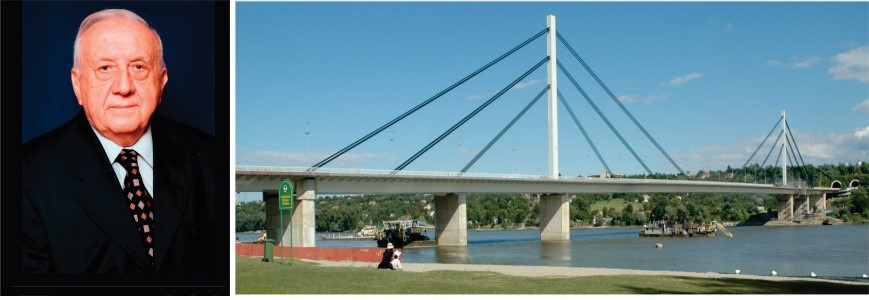
Nikola Hajdin was born on April 4th, 1923 in Vrbovsko, Croatia (part of Yugoslavia at that time). He obtained his elementary education from various places in Croatia, but at the beginning of the Second World War, his family escaped a local Nazi massacre, and moved to Belgrade. After the war, he finished studies at the Civil Engineering Department of the University of Belgrade in 1951, and then completed his PhD in 1956. Hajdin was elected an assistant professor at the same department and then became a professor for the field of structural analysis. He was teaching various courses at all levels, such as Theory of Structures, Strength of Materials, Theory of Thin-Walled Structures at his department, but also at other universities – Zagreb, Ljubljana, Skoplje, Zurich and others. He was also a consultant for a number of leading companies focused on designing and building civil engineering structures in the region and throughout the world. At the Swiss company AG Konrad Zchokke in 1958 he got to know a famous structural engineer Dr. Curt F. Kollbrunner with whom he would collaborate for over 20 years. Besides numerous scientific and practical results, Kollbrunner and Hajdin published two seminal books on the theory of thin-walled structures (Springer 1972, 1975). Prof. Hajdin became a corresponding member of the Serbian Academy of Sciences and Arts (SASA) in 1970 and a full member in 1976. He was the head of Civil Engineering Department, vice-president of SASA, 1994-2003; three-time elected president of SASA, 2003-2015.
Academician Hajdin was devoted to the scientific development of reliable methods for structural analysis, and then to their implementation to the design of civil engineering structures, especially bridges and dams. He introduced a method of integral equations which became widely used before the finite element method became the main tool. Due to deep understanding of the fundamental behavior of structures, academician Hajdin was able to design, as a pioneer in the concept, bridges with suspension cables, which were at the time considered a novelty. He became famous with his exceptional bridges, such as the railway bridge over Sava River in Belgrade (first such bridge in the world, with a span of 550m), the “Sloboda” bridge over Danube in Novi Sad (351m span, shown above as a symbol of his design; destroyed by a NATO bombing raid on April 4th,1999 and reconstructed in 2005 under Hajdin’s supervision) and his bridge over the Visla river in Poland (375m span). Those bridges at the time of their building held world records. He published over 300 papers in various prestigious journals. His unique methodologies and designs had enormous impact in the scientific and engineering communities and were cited and implemented all over the world.
As a professor, academician Hajdin mentored many students including 52 MS and 42 PhD theses, where he was either the head mentor or part of the thesis committee. His research group was continuously involved in various cutting-edge projects. Many of the members of his group became leading professors or engineers not only in Serbia, but throughout the world.
Academician Hajdin had a significant impact on cementing and stabilizing the position of the SASA in the 1990s, which was an especially difficult period in Serbia history.
In the field of computational mechanics, academician Hajdin played a very prominent role. He organized the first computer center in Serbia at the Civil Engineering Department devoted to structural analysis, which, starting in the 1970s, produced many important scientific and practical results. The collaborators of professor Hajdin and he himself inspired a group of researchers at the University of Kragujevac to pursue in implementation of the finite element method and software development, resulting in the first domestic software PAK (Program for Structural Analysis, initiated in 1975). Academician Hajdin was a strong supporter of the Kragujevac group and in 2005, as the president of SASA, he signed a contract between SASA, University of Kragujevac and City of Kragujevac, for establishing the scientific program: Bioengineering at Center for Scientific Research of SASA and University of Kragujevac. This Program and the group at Mechanical Engineering Department of University of Kragujevac, served as the basis for establishing the Serbian Society for Computational Mechanics (SSCM) in 2006. The Program further evolved to the Bioengineering Research and Development Center BioIRC in Kragujevac and academician Hajdin had a strong influence on this development.
Today, we can say that we were lucky in Serbia that we had among us such a great man, scientist, and engineer as academician Nikola Hajdin. We, particularly within the SSCM community, University of Kragujevac and BioIRC, are grateful to academician Hajdin for his encouragement and support over the last four decades. He had a profound influence on us and we will always remember him with the greatest respect and fondness. Rest in peace academician Hajdin.December 2019, Kragujevac, Serbia Milos Kojic


